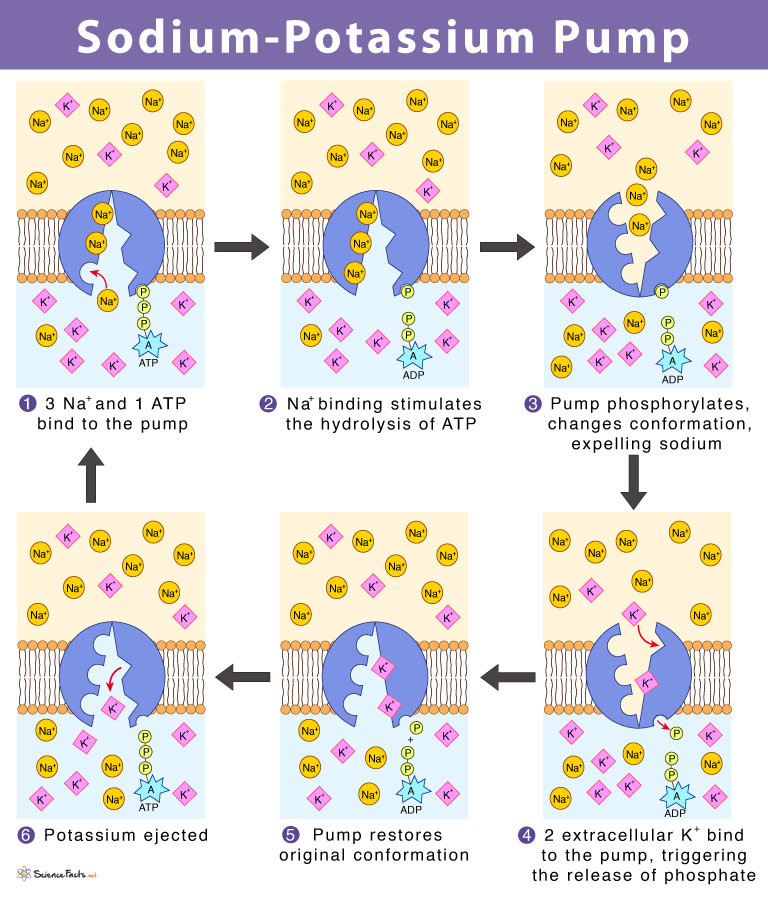Sodium-Potassium Pump
What is the Sodium-Potassium Pump
Sodium-Potassium Pump, also known as the Na+/K+ pump or Na+/K+-ATPase, is a transmembrane protein pump found in animals’ cell (plasma) membrane. Its fundamental purpose is to transport sodium and potassium ions across the cell in the ratio of 3: 2. It means, during one cycle, 3 sodium ions move out for every 2 potassium ions brought in.
Since this entire process requires the cell’s metabolic energy in the form of ATP, it is considered an example of active transport. In the process, the pump helps stabilize membrane potential and is also necessary for creating conditions necessary for firing action potentials.
Danish scientist Jens Christian Skou discovered the Sodium–Potassium pump in 1957. Later in 1997, he was awarded Nobel Prize for the same.
Where is it Located
The Na+/K+ pump is found in the cell membrane of all human and other animal cells.
Structure
The Sodium-Potassium Pump is a P-type ion pump composed of heterodimeric globular protein. It consists of two subunits: α and β.
- α subunit: It is the bigger subunit with a molecular weight of around 100,000 Dalton. α subunit is the catalytic site of the protein that spans the membrane 10 times, with both ends being intracellular. There are 4 isoforms of α (1-4) expressed in a tissue-specific fashion. For example, α2 is expressed in the heart and other muscle cells and plays a crucial role in maintaining blood pressure and heart functions.
- β subunit: It is smaller in size with a molecular weight of around 55,000 Dalton. It passes the membrane only once. There are 3 isoforms of β(1-3) expressed in a tissue-specific fashion.
How does the Sodium-Potassium Pump Work with Steps
As stated above, Na+/K+-ATPase is a ATP-dependent transporter protein that exchanges three sodium ions (exports out of the cell) for every two potassium ions (import into the cell) against the electrochemical gradient.
The detailed mechanism takes place in the following steps:
- Initially, the pump opens at the intracellular site. In this form, the pump has a high affinity for sodium ions and takes up three of them. This state of the protein is called E1.
- When the sodium ions bind, they stimulate the pump to hydrolyze ATP. A phosphate group from ATP gets attached to the pump, and ADP is released as a by-product.
- As a result of phosphorylation, the pump changes shape and re-orients itself. Now it opens towards the extracellular space. This state of the protein is called E2.
- After the conformational change, the pump shows a low affinity towards sodium ions. It allows three sodium ions to be translocated out of the cell. Simultaneously, the pump exposes two potassium binding sites on the extracellular surface of the pump. It allows the binding of two potassium ions, triggering the removal of the previously attached phosphate group.
- With the phosphate group released, the pump now returns to its original conformation, i.e., an opening towards the cell’s interior.
- Finally, the two potassium ions are transported inside the cell, completing the ion exchange.
Functions: Why is it Important
The sodium-potassium pump performs several critical roles in a cell. Some notable ones are described below.
- Cellular Transport: Expulsion of sodium from the cell supplies the driving force for several secondary active transporters, which import glucose, amino acids, and other nutrients inside the cell using the sodium gradient.
For example, the Na, K-ATPase generates the ion gradients responsible for most fluid and electrolyte transport processes in the kidney.
- Maintaining Membrane Potential of the Cell: The Sodium-Potassium pump helps to maintain osmotic equilibrium and membrane potential in cells. Cells usually keep a high level of potassium ions within the cell and a low concentration of sodium ions outside to maintain the cell membrane potential. The pump exports three sodium ions and imports two potassium ions, thus, in total, removing one positive charge from the intracellular space.
- Controlling Cell Volume: Increase in osmolarity (solute concentration per liter of the solution) of the intracellular space compared to outside triggers uptake of water inside the cell through endosmosis. This can cause the cell to enlarge and burst. Activation of Na⁺-K⁺ pump, which is highly sensitive to the changes in Na⁺-K⁺ concentrations, helps maintain proper ionic concentration inside the cell. Failure of the pump can thus cause cell damage, swelling, and rupture of the cell.
- Acting as a Signal Transducer: In addition to the classical ion transporting, Na/K-ATPase acts as a signal transducer. This membrane protein can transfer extracellular ouabain-binding signaling into the cell by regulating the phosphorylation of tyrosine protein.
Protein-protein interactions play a vital role in Na⁺-K⁺ pump-mediated signal transduction. For instance, the pump interacts directly with Src, a non-receptor tyrosine kinase, to form a signaling receptor complex. As a result, Src kinase is inhibited by Na⁺-K⁺ pump on binding to ouabain.
- Controlling Neuron Activity: During the resting state, the sodium-potassium pump maintains a difference in charge across the neuron’s plasma membrane that is critical for transmitting nerve impulses.
The pump also controls and sets the intrinsic activity mode of cerebellar Purkinje neurons, accessory olfactory bulb mitral cells, and probably other neuron types.
-
References
Article was last reviewed on Monday, July 19, 2021




